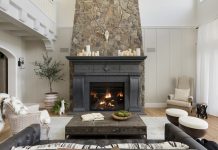
Artist. Master illusionist. Miracle worker. Darril Otto, a decorative painter, plasterer, and founder of Otto Painting Design in Chanhassen, earns these sobriquets and more from clients and collaborators. And he acknowledges each one with a sincere “Thank you” or “You’re very kind.” But he and his small team of artisans work with leading designers, architects, and builders to make illusions corporal. Whatever the vision for walls, ceilings, built-ins, or bespoke furniture, Otto’s response is, “Well, we can create that for you.” The self-taught artist then uses paint, plaster, wax, pigments, metals, and a liberal sprinkling of magic to do exactly that.
You’re known as a decorative paint and plaster specialist, but that doesn’t really capture what you do.
I tell people we do surface treatments. People say, “That’s lame. Like, what is that?” (laughs). Basically, we do plaster, wood, metal, and concrete. We’ve made handmade wall coverings with metal leaf—we do gold leaf and silver leaf, and we do lots of unique [treatments] for furniture.

Are you involved at the behest of the architect, the designer, or the homeowner?
All of the above. The builder, too. Our design community here is amazing. Because we’ve been doing it for so long now, we’ve been fortunate to collaborate with lots of designers and architects. Generally, one of the creatives will reach out because they’re looking for a [specific finish] or they’ll ask us, “What are you excited about or what are you doing that’s different?” And we’ll go from there.
What’s your part in the creative process?
A feeling is what drives everything—that’s what we ultimately want to create and leave behind. People might say, “Oh, I want Venetian plaster,” but what they’re really after is a certain look or feel. They just don’t know how to get there. The process, for us, is listening and establishing trust so clients open up. We talk—and listen—until we know what they want, and then we create it for them.
What is the range of work you do?
We’ll do a dining table, and we’ll do a 20,000-square-foot house. We’re doing plaster, cabinetry, beams, and wood ceilings in a project we’re working on right now. It helps to work on different materials to really understand how to coax the feeling out of them. The approach is always multiple steps to bring the most out of the material without masking it.

Give me an example of how you do that.
Here’s a story for you: We’re working on this technique where you get rid of all the imperfections in [a piece of wood]. Then you treat it, so you’re flooding the wood grain, but it literally does not look like it has any finish on it. We did that to these components of a door that was being made out in Seattle. We shipped them off, and then I got an email saying, “Well, the good news is the panels arrived on time and they’re not damaged. The bad news is they’re unfinished.” [I replied], “That is the greatest compliment you could have ever given me… They are finished. Pour water on them.”
The point is, instead of dressing up a surface like it’s going out to prom or something, you’re getting out of the way and letting it be what it wants to be. That’s always been the most enjoyable thing for me.




















